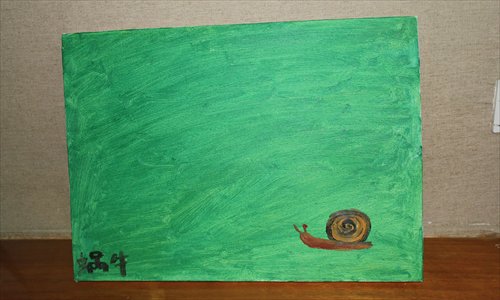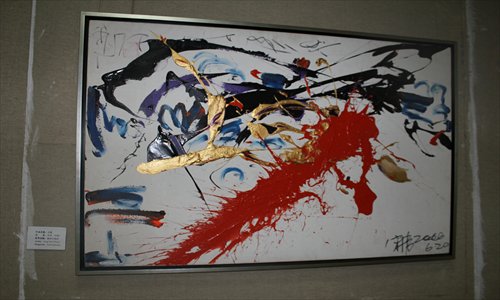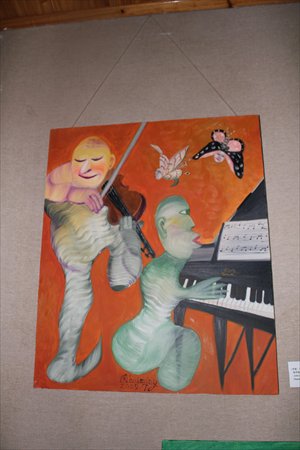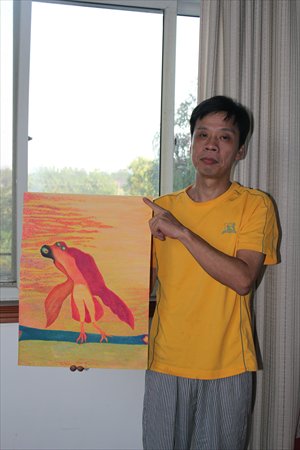Home >> LIFE
Art Therapy
By Xu Ming Source:Global Times Published: 2012-8-2 20:55:03

Painting of a snail

Painting by Song Wei


Painting by Zhou Huiming

Wu Meifei poses with painting Photos:Xu Ming/GT
Guo Haiping tried every way possible to persuade Wu Meifei, an artist who came to Guo's center, to stay longer. But Guo's efforts were futile. Wu is schizophrenic, a severe mental disorder characterized by the lack of ability to be in touch with reality. But he is in a better condition now.
Guo, the founder of Nanjing Natural Art Center (NNAC), said that it is difficult to find resident artists for the center.
NNAC is the first non-profit institution in the Chinese mainland that focuses on exploring art created by mentally ill people, including those with schizophrenia and autism. Built in 2010, the center provides them with a space to exhibit their talent in artistic creations.
The center now exhibits over 70 works from Chinese and foreign artists. Some were collected from hospitals and some were bought from galleries in other countries.
Though Wu's older sister tried to convince him to stay longer, Wu still asked to leave the following week. Guo felt frustrated, but for him, this is just one of the numerous difficulties in running the center and starting an outsider art movement in China.
Paving the way
"We cover their travel fees and daily expenses here and provide them materials [for painting]. They can freely express themselves in painting here, away from society. Some other artists have said these works resemble that of world-class masters," Guo said, pointing to the exhibited paintings.
Wu, 45, a native of Nanping, Fujian Province, has been painting since 2003. His work is shockingly beautiful and meticulous.
"Painting makes me feel tranquil," he said.
The word "art brut," or outsider art, was coined by French painter Jean Dubuffet in 1962 and refers to art forms that rely little on traditional art theories. Such art is created by people outside the art circle. These artistic works go beyond the palpable experience and are created by unprofessional or mentally ill people.
Guo said that art brut is regarded as an important movement that drives forward the development of art in the West. But in China, this movement has been largely neglected.
"They [mentally ill people] see things from a different angle, unaffected by society," Guo explained."They show us an untainted inner world."
Guo created a venue for creative people with mental disorders six years ago. He originally built a small "art ward" in a hospital for patients who loved art, but it was shut down.
Years later, Guo received financial support from Zeng Lihua, a fellow supporter, to build a center dedicated to providing art space for mentally ill people. Zeng has annually invested 300, 000 yuan ($47,980) in the center for three years, starting from 2010.
Building camaraderie
Guo said that there is currently a lack of financial and policy support in operating the center.
"I have no idea where the next investment will come from, as Zeng's support will come to an end next year," he said.
The center is located in Jiangxinzhou, a remote island in Nanjing, Jiangsu Province. The rent here is significantly lower than the main downtown areas.
"It would attract more attention if it was located in the inner city," said Guo, "But [for now], we must do with this place."
The most difficult part is not dealing with finances but changing people's perceptions about this demographic of largely invisible people.
NNAC states on its website that it hopes visitors will learn more about the mentally ill demographic and change preconceived notions.
"For a long time, people have been looking at this group with bias, a sense of superiority and a charitable sympathy," Guo said."It is hard to ask people to treat them equally, appreciate their works and encourage their creativity."
Such an environment hinders the development of art brut, he said. Guo found it very difficult to persuade hospitals, doctors and even families to cooperate.
"There is an invisible wall between the patients and the world. And it is painful to see many geniuses degenerate under the influence of medicine," Guo said.
"Many doubt that mentally ill patients can draw," he continued. "Some say such works are children's play. Some artists question the value of their work as well, because they don't want to be compared on equal terms with these people."
It takes time for this group of people to be accepted by society. Guo emphasizes the importance of the Law on Mental Health to be enacted, which China has been working on for years.
The Law on Mental Health provides a legal base for mentally ill people to have basic rights and respect.
Growing number
Earlier last month, Hans Looijen, the director of Het Dolhuys, Esther Vossen, exhibition planner for Het Dolhuys, and Lisa Brown, founder of Workman Arts visited NNAC and talked about the possibility of Nanjing hosting the 4th International Madness and Art Festival (MAF).
In previous years, the festival was hosted in Canada, the Netherlands and Germany. MAF is a reoccurring international and interdisciplinary manifestation of art and madness. MAF provides a stage for people with and without psychiatric background, artists, scientists and the public.
"China's influence is growing internationally, and so the country should also do something in this field," said Guo.
NNAC has attracted much international attention since its establishment. Now both the MAF and the Nanjing's city government are considering the idea.
"If held, the festival will push China's art brut development at least 10 years forward," Guo said.
It is also a movement that needs joint efforts from the government, society and NGOs, Guo said.
There is hope for change for the younger generation. Zhang Zhiwei, Guo's assistant said that about 90 percent of the visitors at the center are young people born in the 1980s.
In the West, art has been widely regarded as the best way to treat mentally ill people. Most countries in Europe and America have art centers that engage them in art creation and recovery, Guo said.
The National Center for Mental Health revealed in 2009 that there are around 100 million people with various mental disorders in China. Over 16 million of them are seriously mentally ill.
The WHO said that the best way to treat these people is to integrate them into society. For patients with talents in art, the best way is to let them draw and create.
"But I cannot be optimistic as long as the Law on Mental Health has not come out, and the art education in China continues to neglect art brut," Guo told Global Times.
Guo, the founder of Nanjing Natural Art Center (NNAC), said that it is difficult to find resident artists for the center.
NNAC is the first non-profit institution in the Chinese mainland that focuses on exploring art created by mentally ill people, including those with schizophrenia and autism. Built in 2010, the center provides them with a space to exhibit their talent in artistic creations.
The center now exhibits over 70 works from Chinese and foreign artists. Some were collected from hospitals and some were bought from galleries in other countries.
Though Wu's older sister tried to convince him to stay longer, Wu still asked to leave the following week. Guo felt frustrated, but for him, this is just one of the numerous difficulties in running the center and starting an outsider art movement in China.
Paving the way
"We cover their travel fees and daily expenses here and provide them materials [for painting]. They can freely express themselves in painting here, away from society. Some other artists have said these works resemble that of world-class masters," Guo said, pointing to the exhibited paintings.
Wu, 45, a native of Nanping, Fujian Province, has been painting since 2003. His work is shockingly beautiful and meticulous.
"Painting makes me feel tranquil," he said.
The word "art brut," or outsider art, was coined by French painter Jean Dubuffet in 1962 and refers to art forms that rely little on traditional art theories. Such art is created by people outside the art circle. These artistic works go beyond the palpable experience and are created by unprofessional or mentally ill people.
Guo said that art brut is regarded as an important movement that drives forward the development of art in the West. But in China, this movement has been largely neglected.
"They [mentally ill people] see things from a different angle, unaffected by society," Guo explained."They show us an untainted inner world."
Guo created a venue for creative people with mental disorders six years ago. He originally built a small "art ward" in a hospital for patients who loved art, but it was shut down.
Years later, Guo received financial support from Zeng Lihua, a fellow supporter, to build a center dedicated to providing art space for mentally ill people. Zeng has annually invested 300, 000 yuan ($47,980) in the center for three years, starting from 2010.
Building camaraderie
Guo said that there is currently a lack of financial and policy support in operating the center.
"I have no idea where the next investment will come from, as Zeng's support will come to an end next year," he said.
The center is located in Jiangxinzhou, a remote island in Nanjing, Jiangsu Province. The rent here is significantly lower than the main downtown areas.
"It would attract more attention if it was located in the inner city," said Guo, "But [for now], we must do with this place."
The most difficult part is not dealing with finances but changing people's perceptions about this demographic of largely invisible people.
NNAC states on its website that it hopes visitors will learn more about the mentally ill demographic and change preconceived notions.
"For a long time, people have been looking at this group with bias, a sense of superiority and a charitable sympathy," Guo said."It is hard to ask people to treat them equally, appreciate their works and encourage their creativity."
Such an environment hinders the development of art brut, he said. Guo found it very difficult to persuade hospitals, doctors and even families to cooperate.
"There is an invisible wall between the patients and the world. And it is painful to see many geniuses degenerate under the influence of medicine," Guo said.
"Many doubt that mentally ill patients can draw," he continued. "Some say such works are children's play. Some artists question the value of their work as well, because they don't want to be compared on equal terms with these people."
It takes time for this group of people to be accepted by society. Guo emphasizes the importance of the Law on Mental Health to be enacted, which China has been working on for years.
The Law on Mental Health provides a legal base for mentally ill people to have basic rights and respect.
Growing number
Earlier last month, Hans Looijen, the director of Het Dolhuys, Esther Vossen, exhibition planner for Het Dolhuys, and Lisa Brown, founder of Workman Arts visited NNAC and talked about the possibility of Nanjing hosting the 4th International Madness and Art Festival (MAF).
In previous years, the festival was hosted in Canada, the Netherlands and Germany. MAF is a reoccurring international and interdisciplinary manifestation of art and madness. MAF provides a stage for people with and without psychiatric background, artists, scientists and the public.
"China's influence is growing internationally, and so the country should also do something in this field," said Guo.
NNAC has attracted much international attention since its establishment. Now both the MAF and the Nanjing's city government are considering the idea.
"If held, the festival will push China's art brut development at least 10 years forward," Guo said.
It is also a movement that needs joint efforts from the government, society and NGOs, Guo said.
There is hope for change for the younger generation. Zhang Zhiwei, Guo's assistant said that about 90 percent of the visitors at the center are young people born in the 1980s.
In the West, art has been widely regarded as the best way to treat mentally ill people. Most countries in Europe and America have art centers that engage them in art creation and recovery, Guo said.
The National Center for Mental Health revealed in 2009 that there are around 100 million people with various mental disorders in China. Over 16 million of them are seriously mentally ill.
The WHO said that the best way to treat these people is to integrate them into society. For patients with talents in art, the best way is to let them draw and create.
"But I cannot be optimistic as long as the Law on Mental Health has not come out, and the art education in China continues to neglect art brut," Guo told Global Times.
Posted in: Profile